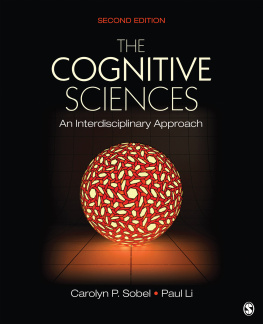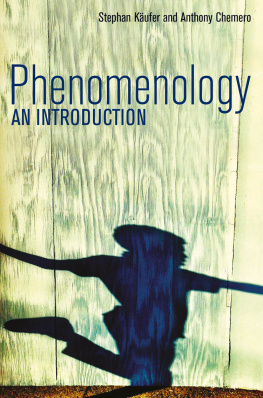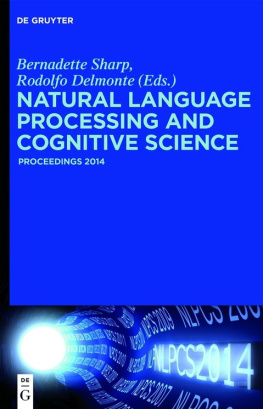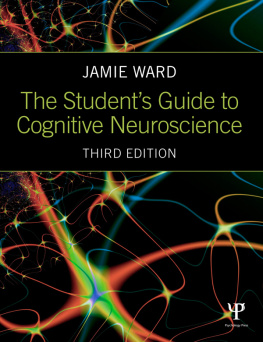FOR INFORMATION:
SAGE Publications, Inc.
2455 Teller Road
Thousand Oaks, California 91320
E-mail: order@sagepub.com
SAGE Publications Ltd.
1 Oliver's Yard
55 City Road
London EC1Y 1SP
United Kingdom
SAGE Publications India Pvt. Ltd.
B 1/I 1 Mohan Cooperative Industrial Area
Mathura Road, New Delhi 110 044
India
SAGE Publications Asia-Pacific Pte. Ltd.
3 Church Street
#10-04 Samsung Hub
Singapore 049483
Copyright 2013 by SAGE Publications, Inc.
All rights reserved. No part of this book may be reproduced or utilized in any form or by any means, electronic or mechanical, including photocopying, recording, or by any information storage and retrieval system, without permission in writing from the publisher.
Printed in the United States of America
Library of Congress Cataloging-in-Publication Data
Sobel, Carolyn Panzer.
The cognitive sciences: an interdisciplinary approach / Carolyn Panzer
Sobel. 2nd ed.
p. cm.
Includes bibliographical references and index.
ISBN 978-1-4129-9716-4 (cloth)
1. Cognitive science. I. Title.
BF311.S637 2014 153dc23 2012037730
This book is printed on acid-free paper.
12 13 14 15 16 10 9 8 7 6 5 4 3 2 1
Acquisitions Editor: Vicki Knight
Production Editor: Brittany Bauhaus
Copy Editor: Michelle Ponce
Typesetter: C&M Digitals (P) Ltd.
Proofreader: Eleni-Maria Georgiou
Indexer: Rick Hurd
Cover Designer: Candice Harman
Marketing Manager: Lisa Sheldon Brown
Permissions Editor: Adele Hutchinson
Preface
Many people are intrigued by cars. To some, they represent status; to others, power. Some people respond to the design of cars and can recite the features of every style produced by every manufacturer in any given year. Others, like me, view a car as a means of transportation onlyone that should perform well and with minimal care and preferably be equipped with certain comforts, such as air conditioning and power steering. Beyond that, they do not give cars a thought.
There are times, though when aspects of a car do claim the attention of even such nonenthusiasts. For instance, once, when stopped at a red light, I found myself behind a Honda Civic (a fairly frequent occurrence, given the number of Honda Civics on the road). Staring at the back of the car, I noticed that the word CIVIC is a palindromea word or sentence that, like eve or mom or Madam I'm Adam, reads the same forward and backward. Now, CIVIC is strictly a spelling, or symbolic, palindrome, not a visual one, because the final C faces the same direction as the initial C. Of course it doesit's a C, after all, and that's what a C looks like. But if you mentally rotate the final C, you will see that CIVIC is now a visual palindrome: a pattern that looks the same forward and backward. But it is no longer a symbolic palindrome, because a backward C is not really a C; it's just a meaningless mark, and the pattern no longer spells the word.
But as I was saying, I was waiting at a red light. When it changed, my palindrome pulled away. I followed suit, and, because the road was a familiar one, I put the car on automatic pilot, as it were, and continued to think. I wondered whether the company had been aware of the palindromic nature of the name and had chosen the name deliberately for that reason and whether anyone else on the road was struck by it or even noticed it was a palindrome.
Remembering this now, I'm sure that if anyone had asked I would have been unable to report the color of the car or the number of passengers in it or anything but that it had in fact been a palindromic Honda CIVIC. I was, instead, following my own train of thought, which led to a new question: How does it happen that people notice such different aspects of a situation? And is that why, when remembering, their recollections are so different? What is it that causes them to notice different things in the first place? Does it have to do, perhaps, with what was in their minds just before the experience in question? I knew that the effect of one experience could somehow prime people's mental associations, call forth an idea or a name suggested by that experience even though it was not itself uppermost in their minds at the moment.
My own mind was wanderingsuddenly I was home and without a sense of having traversed the route at all, having failed to notice anything about where I was or where I was going until I got therean experience surely familiar to you. I had been conscious only of my thoughts, yet something had enabled me to find my way home without mishap. At some level, parts of my mind had been ticking away, doing what needed to be done, without my having consciously directed them. And now I was busy thinking about my thinking and marveling that I was, even then, thinking about how I was thinking about my thinking
Contained in the little episode just recounted are a number of the mental phenomena addressed by the field of cognitive science: memory, associative thinking, abstract thinking, mental imagery, language, and consciousness. But what exactly is cognitive science? The field is not as familiar to most people as are the subjects traditionally offered in educational institutions. We all have some notion, for example, of the concerns of history, physics, and literature. But the focus of cognitive science is the human mind itself, and thus it necessarily cuts across many disciplines. These disciplines include some that have been around for a long time and some that have come onto the scene relatively recently. Issues traditionally addressed by philosophers about the nature of meaning and the nature of knowing are examined today through the various lenses provided by cognitive psychology, neuroscience, linguistics, artificial intelligence, and of course, philosophy itself, which is alive and well. As long as researchers in each of these fields peer only through the lenses of their own fields, relevant material from the others is not available to them. Valuable insights may thus be lostinsights that can increase our understanding of the burning questions for humanity, motivated by a powerful wish to understand ourselves: What exactly is the intelligence with which we seem uniquely endowed? Are we correctly characterized as animals that think? Machines that feel? What is the thing we experience as consciousnessand is our species alone in it as each individual is alone in it? At its most simply stated but most fundamental, the pivotal question for humanity is: Who are we?
There is a greater likelihood of our being able to answer this question, and all the questions that go with it, if the different perspectives of the fields concerned with them are accessible to, and invited to inform, the others. Integrating into a more coherent whole the knowledge gained by each field will contribute to a clearer understanding of the entity that has long mystified our species: our own human mind. New ways of thinking, some arising from technologies newly developed, permit us now to reconsider this old enigma.









